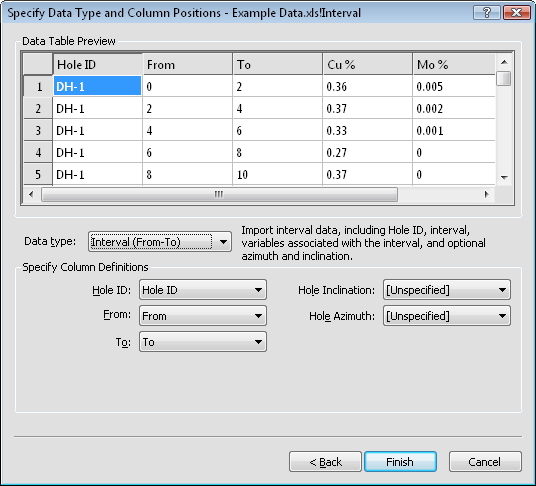
The Specify Data Type and Column Position dialog is used to define the table type and match the data to the table's required columns.

Set the Data type and columns in the Specify Data Type and Column Positions dialog.
The Data Table Preview section displays the data contents.
The data should fall into one of six types of tables: Depth (Single Depth), Interval (From-To), Lithology, Well Construction, Collars, Survey, or Text (General). Select the desired table type. Notice that the Specify Column Definitions change based on the type of table selected. To set the type, click on the existing type and select the desired table type from the list. A description of the selected type appears to the right of the Data type list.
Once the data type is determined in the Data type section, the required data column for the data type are shown in the Specify Column Definitions section. Match the data to the columns for the table type. Each column definition can be set to any column in the file by clicking on the existing column name and selecting the desired column from the list. If a column should not be imported, select [Unspecified]. The column is created, but contains no data. If you are unsure which column is appropriate for a required column definition you can select the [Unspecified] option and make the selection after the data appears in a table.
Depth (Single Depth) tables have a single column containing depth information. You must assign a data column to the Hole ID and Depth columns. The Depth column information is required. The Hole Inclination (or Hole Dip) and Hole Azimuth columns can remain [Unspecified].
Interval (From-To) tables have two columns containing depth information: From and To. You must assign data to the Hole ID, From, and To columns. The From and To columns are required. The Hole Inclination (or Hole Dip) and Hole Azimuth columns can remain [Unspecified].
Lithology tables have two columns containing depth information: From and To. You must assign data to the Hole ID, From, To, and Lithology Keyword columns. The Lithology Description, Hole Inclination (or Hole Dip), Hole Azimuth, Indent Percentage, Indent Keyword, and Indent Line Scale columns can remain [Unspecified]. The columns are created, but can remain empty.
Well Construction tables have two columns containing depth information: From and To. You must assign data to the Hole ID, From, To, Offset, Well Item, Inner Diameter, and Outer Diameter columns. The Hole Inclination (or Hole Dip) and Hole Azimuth columns can remain [Unspecified].
Collars tables are informational tables that typically contain information about a borehole such as the location. You can assign data to the Hole ID, Starting Depth, Ending Depth, Elevation, Hole Inclination (or Hole Dip), Hole Azimuth, Easting, Northing, and Scale columns. The Hole ID is the only required column. All other columns can remain [Unspecified]. The Starting Depth can be set to [0] if all boreholes have the same starting depth and the starting depth is not listed in a column in the file.
Survey tables are information tables that contain downhole directional information. You can assign data to the Hole ID, Depth, Hole Inclination (or Hole Dip), and Hole Azimuth columns. All four columns are required if you wish to use the Survey table for true vertical depth calculations.
Text tables are general tables. You can assign to the Hole ID column. There are no required columns in this table.
All other data are imported into columns with the column title indicated in the Specify Worksheet Column Definitions or Database Tables and Fields dialogs.
When a line/symbol, zone bar, bar, post, classed post, complex text, or graphic log is selected before the Specify Data Type and Column Positions dialog appears, an extra Data column is available. Click on the existing column name and select the desired column from the list. The log type is automatically created with the Data Column set to the selected column. If left to [Auto], the first column of data is displayed for the log.
See Also
Lithology Data, Schemes, and Logs
Well Construction Data, Schemes, and Logs